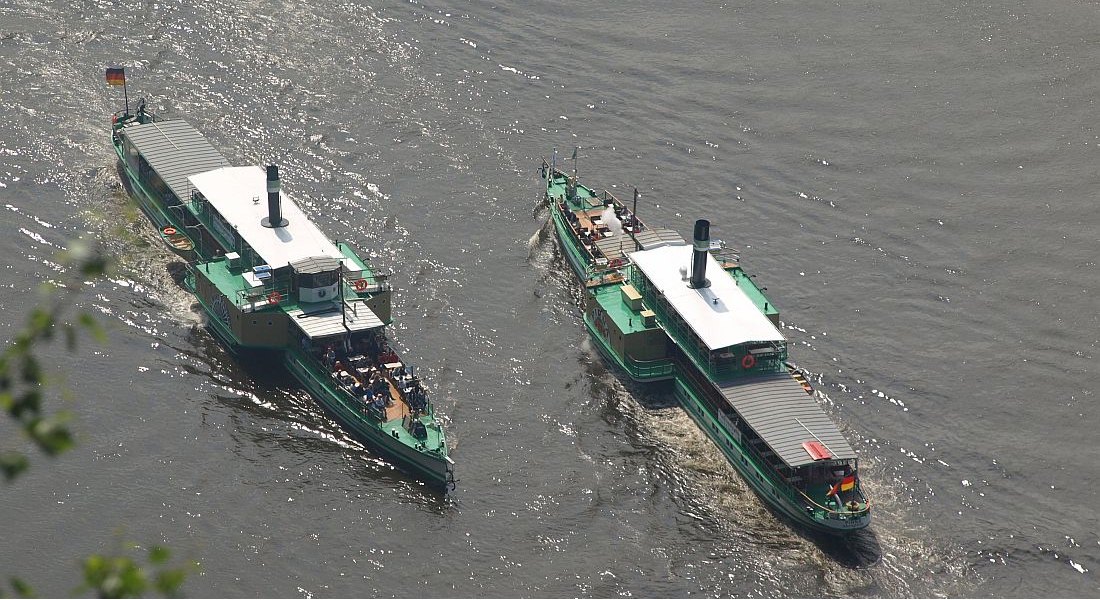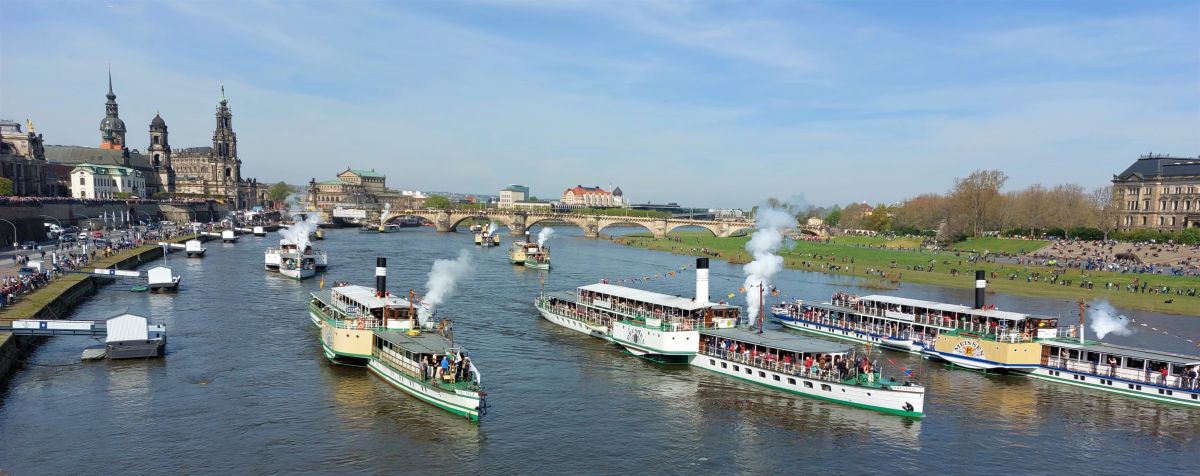
paddlesteamers.info : The Internet's leading website for Side-Wheeled Paddle Steamers

Encouraged by preservation groups, the decision was taken to retain and recondition the paddle steamer fleet after the change of ownership following the demise of the German Democratic Republic. The four more modern diesel-electric paddlers have been disposed of, two of which went to the breakers yard. Paddle Steamers Schmilka (1897) and Junger Pionier (1898) were still in existence at Dresden-Neustadt harbour, but in poor condition, and their hulls were later scrapped. Two large new motor vessels were introduced.
All nine current vessels were built in the local
shipyard, originally Blasewitz, later Laubegast, and have
served their life on the Elbe with the exception of Krippen.
She was re-purchased in November 1999, having been sold out
of the fleet in 1979 and led a nomadic existence including
static preservation and latterly service for the KD company
on the River Main at Frankfurt.
Periodic reconditioning throughout their lives, culminating
in major renovation in 1992/3 has ensured that the vessels
remain in top condition. The latest refits involved
returning the vessels as far as possible to their original
form whilst incorporating all the required new safety
features. Vessel lengths are in the 52-70 metre range, with
draughts varying after the various reconditions which have
generally involved adding new superstructure and equipment.
Several of the older existing vessels have been lengthened
during the earlier part of their lives. Inevitably, new
boilers have had to be installed, especially during 1992/3,
but all vessels retain their original engines. Stadt Wehlen
(1915), Meissen (1914) and Pillnitz (1912) had their power
rating increased through the rebuilding of their machinery.
All have oscillating engines, except the two most modern
paddlers, Dresden and Leipzig , which have two-cylinder
compound diagonal machinery. The vessels of the Dresden
fleet have in many cases undergone several name changes
(post World War I all names relating to royalty were dropped
in favour of local place names) and several ships have
carried the same name.
PS Stadt
Wehlen (1879)
PS Diesbar (1884)
PS Meissen (1885)
PS Pillnitz (1886)
PS Krippen (1892)
PS Kurort Rathen (1896)
PS Pirna (1898)
PS Dresden (1926)
PS Leipzig (1929)
It is often overlooked that the world's largest paddle steamer
fleet is based on the River Elbe at Dresden, Germany. Once concealed
behind the "Iron Curtain", it might have been assumed
that in the 1990s, the harsh economic realities of the "capitalist"
West would see a great diminishing of the fleet, which had several
paddlers around 100 years old in its ranks. Not so. These ships
have been magnificently re-fitted and now provide an intensive service
on a beautiful stretch of river deep in the European heartland.
The
accepted wisdom is that it is too expensive to run paddle steamers and that
any business-orientated venture would normally retire its older vessels and
replace them with more modern ships with lower opreating costs. Where paddlers
can be retained, it should be as special members of a much larger fleet where
the profits earned by the motor vessels can be used, in part, to subsidise the
"heritage" operation of a paddle steamer. Such an outcome was to be
feared when the collapse of the communist system in eastern Germany and the
subsequent incorporation of this country into the Federal Republic of Germany
took place in 1991. Market economics, even more so than a socialist system,
would surely ensure that a fleet of century-old vessels could not continue to
operate, particularly as the "White Fleet" at Dresden was sold off
to corporate interests.............
The paddler Schmilka (1878) was
laid up awaiting possible repair and Leipzig (1929) was awaiting a major refit.
The fleet numbered nine operational paddlers and eight motor ships, three of
which were diesel-powered paddlers. In 1991, five paddlers were in service and
five laid up. A buyer was sought by the "Treuhandanstalt", the federal
body charged with disposing of state assets. An offer was accepted from the
Conti Shipping company, a very large company involved in deep-sea shipping, in association with
the local state government of Saxony which had come together in an unusual partnership,
with the involvement of the state regarded by enthusiasts as a possible ally
in preventing the wholesale decimation of the paddler fleet. The state of Saxony owns 51% of the company. As it happened,
the Conti company's intentions were good and the "Sachsische Dampfschifffahrts GmbH
& Co, Conti Elbschiffahrts AG" took control in November 1992, with
a commitment to 21 Million Deutschemarks of investment and a pledged to retain
at least seven paddle steamers. Immediately, contracts were placed for the complete
refurbishment of eight paddlers and the construction of two large new motor
vessels.
The new company decided not to refit the three remaining of
the four diesel paddlers despite their being relatively young (under 30 years
old), and two sister paddlers, the laid up Schmilka and Junger Pionier, which
had been out of service were scrapped but their oscillating engines were retained
for possible future use. This meant that their were eight paddlers now in the
planned fleet - but, incredibly, this was increased to nine when PS Krippen,
which had been paid off as early as 1983, was repurchased in 1999.
The
refurbishment and modernisation of the eight paddlers has been undertaken to
a very high standard and they are now maintained in excellent condition - and
most are in service most of the time in a long season. The
operating company has showing that it is perfectly possible to run a fleet
predominantly of paddle-steamers (and extremely old ones at that....) even
when it has to answer to a large corporation. Continued investment
in the paddlers has meant that there has not been any suggestion of replacement
by new motor vessels and the Dresden area now has a magnificent fleet of beautiful
steamers - justifiably the largest, and quite possibly, the finest in the world.
In
2020 the operators went into administration following a number of years
of problems with variable water levels in the Elbe compounded in 2020
by the effects of the worldwide Coronavirus pandemic. It continued to
operate under the existing management until the beginning of September
when the company was bought by the Swiss shipping company River Advice
AG. River Advice own and operate a large number of the river cruise
ships in Europe and also the KD Koln-Dusseldorfer line, operators of
paddle ship Goethe on the Rhine. A new company, Weisse Flotte Sachsen
GmbH was formed and the nine paddle steamers vested in a special
historical steamers subsidiary, Kulturerbe Dampfschiffe Dresden GmbH.

It is not everywhere where it is possible to get a bird's eye view of paddle steamers from dry land.......but along the Elbe south of Dresden gives some excellent opportunities. Many thanks to Malcolm Oliver for the photo above
BIBLIOGRAPHY